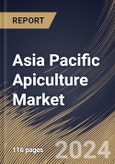Innovation in hive design includes the development of smart hives equipped with sensors and communication devices. These hives offer insights into colony health, temperature regulation, and swarm detection. Exploring sustainable and eco-friendly materials for hive construction is a notable trend. Beekeepers are increasingly opting for materials that minimize environmental impact. Beekeepers, environmental organizations, and governments are forming collaborative partnerships to promote bee-friendly practices, protect habitats, and address challenges such as pesticide use.
Awareness campaigns and educational initiatives focused on the importance of bees in ecosystems and food security are gaining momentum. These efforts contribute to public support for bee conservation. Additionally, large-scale commercial beekeeping operations cater to the demand for honey and bee-derived products. These enterprises often involve migratory beekeeping for crop pollination services on a massive scale. It has expanded with the export and trade of honey and related products. Countries with favorable climates for beekeeping contribute significantly to the market.
The cosmetics industry in South Korea has witnessed a growing preference for products with natural and environmentally friendly ingredients. Honey and other bee-derived ingredients are valued for their natural properties, potentially leading cosmetic companies to seek locally sourced honey. As per the data from the International Trade Administration, for 2021, the total value of cosmetics produced in South Korea was $14.5 billion, and cosmetics exports hit a record high, growing 21.3 percent from the previous year to $9.2 billion. South Korea’s trade surplus in the cosmetics sector grew by 28.6 percent to $7.8 billion. Hence, the rising cosmetics and pharmaceuticals sectors in Asia Pacific is beneficial for the growth of the regional market.
The China market dominated the Asia Pacific Apiculture Market, by Country in 2022, and would continue to be a dominant market till 2030; thereby, achieving a market value of $1,736.1 Million by 2030. The Japan market is registering a CAGR of 5.1% during (2023 - 2030). Additionally, The India market would showcase a CAGR of 6.4% during (2023 - 2030).
Based on Application, the market is segmented into Food & Beverage, Pharmaceuticals, Personal Care & Cosmetics, and Others. Based on Type, the market is segmented into Honey, Royal Jelly, and Beeswax. Based on countries, the market is segmented into China, Japan, India, South Korea, Singapore, Malaysia, and Rest of Asia Pacific.
List of Key Companies Profiled
- Capilano Honey Ltd.
- YS Organic Bee Farms
- Dabur India Ltd.
- NOW Health Group, Inc.
- Koster Keunen, Inc.
- Barkman Honey, LLC
- Fairfield Organics, LLC
- Strahl & Pitsch, LLC.
- Miller's Honey Company
- Durham's Bee Farm, Inc.
Market Report Segmentation
By Application (Volume, kilo Tonnes, USD Billion, 2019-2030)- Food & Beverage
- Pharmaceuticals
- Personal Care & Cosmetics
- Others
- Honey
- Royal Jelly
- Beeswax
- China
- Japan
- India
- South Korea
- Singapore
- Malaysia
- Rest of Asia Pacific
Table of Contents
Companies Mentioned
- Capilano Honey Ltd.
- YS Organic Bee Farms
- Dabur India Ltd.
- NOW Health Group, Inc.
- Koster Keunen, Inc.
- Barkman Honey, LLC
- Fairfield Organics, LLC
- Strahl & Pitsch, LLC.
- Miller's Honey Company
- Durham's Bee Farm, Inc.
Methodology

LOADING...








